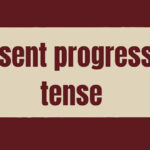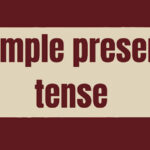Tense is a grammatical concept that refers to the time of an action or event described in a sentence.
It indicates whether the action or event is happening in the present, has already happened in the past, or will happen in the future.
In English, there are three primary tenses: past, present, and future.
1. Past tense:
This tense is used to describe actions or events that have already happened.
In English, regular verbs typically add “-ed” to the base form to indicate the past tense (e.g., “walked,” “talked”).
However, irregular verbs have their own unique forms (e.g., “went,” “ate”).
Example:
I studied for the exam last night.
2. Present tense:
This tense is used to describe actions or events that are currently happening or are generally true.
The present tense does not indicate a specific time frame; it can refer to the present moment or to habitual actions.
Example:
She reads a book every evening.
3. Future tense:
This tense is used to describe actions or events that will happen at a later time, after the present.
In English, the future tense is often formed using auxiliary verbs such as “will” or “shall” followed by the base form of the verb.
Example:
They will visit their grandparents next week.
In addition to these primary tenses, there are also other tenses that express different aspects or nuances of time, such as the present perfect, past perfect, future perfect, and continuous tenses.
These tenses combine the basic tenses with other verb forms or auxiliary verbs to convey more specific meanings.
TWELVE TENSES
In English, there are a total of 12 tenses. They are formed by combining the basic tenses (past, present, and future) with other aspects and auxiliary verbs to express different shades of time and duration.
Here is a breakdown of the 12 tenses:
1. Simple Present:
Describes actions or events that are happening now or are generally true.
Example: I play tennis every Sunday.
2. Simple Past:
Describes actions or events that have already happened.
Example: She finished her homework yesterday.
3. Simple Future:
Describes actions or events that will happen in the future.
Example: We will go to the movies tomorrow.
4. Present Continuous:
Describes actions or events that are happening now or in the near future.
Example: They are watching a movie tonight.
5. Past Continuous:
Describes actions or events that were happening in the past.
Example: I was studying when she called.
6. Future Continuous:
Describes actions or events that will be happening in the future.
Example: He will be working late tomorrow.
7. Present Perfect:
Describes actions or events that happened in the past but have a connection to the present.
Example: We have visited that museum before.
8. Past Perfect:
Describes actions or events that happened before another action or event in the past.
Example: She had already left when I arrived.
9. Future Perfect:
Describes actions or events that will be completed before a specific time or future action.
Example: By next year, he will have finished his degree.
10. Present Perfect Continuous:
Describes actions or events that started in the past, continue in the present, and may continue into the future.
Example: They have been working on the project all day.
11. Past Perfect Continuous:
Describes actions or events that started and continued in the past and were still ongoing before another past action or event.
Example: She had been waiting for an hour before the bus finally arrived.
12. Future Perfect Continuous:
Describes actions or events that will have been ongoing for a specific duration of time before a future action or event.
Example: By 5 p.m., I will have been working here for 10 years.
These 12 tenses allow for a comprehensive representation of various time relationships and durations in English.
HOW TO IDENTIFY TENSES
To identify the tense of a verb in a sentence, you need to consider the form of the verb and the context of the sentence. Here are some guidelines to help you identify the tense:
1. Look for keywords:
Pay attention to time-related words or phrases that indicate a specific time frame, such as “yesterday,” “last week,” “tomorrow,” “in two hours,” etc.
These can give you clues about the tense.
2. Identify auxiliary verbs:
Auxiliary verbs (also called helping verbs) are often used to form different tenses.
Common auxiliary verbs in English include “be,” “have,” and “will.” Look for these verbs and observe how they are used in combination with the main verb to determine the tense.
3. Observe verb forms:
Regular verbs in English form the past tense by adding “-ed” to the base form, while irregular verbs have their own unique past tense forms.
The present tense usually matches the base form of the verb.
By examining the verb form, you can identify the tense.
4. Consider sentence structure:
The sentence structure can provide additional clues to identify the tense.
For example, the presence of time adverbs or time clauses can indicate a specific tense.
5. Pay attention to verb phrases:
Verb phrases can provide important information about the tense.
For example, the use of “have been” indicates the present perfect continuous tense, while “had been” suggests the past perfect continuous tense.
By combining these strategies and analyzing the verb form, auxiliary verbs, keywords, sentence structure, and context, you can identify the tense of a verb in a sentence more accurately.
It’s important to consider all these factors together to determine the appropriate tense.
USES
We use tense in language to indicate the time at which an action or event takes place.
Tense allows us to express when something happened, is happening, or will happen.
Here are a few reasons why we use tense:
1. Time reference:
Tense provides a reference point in time, helping us communicate when an action or event occurred.
By using different tenses, we can specify if something happened in the past, is happening in the present, or will happen in the future.
This temporal information is essential for effective communication and understanding.
2. Sequence of events:
Tense helps us establish the order or sequence of events. It enables us to express which actions or events happened first, second, or later in relation to each other.
This sequencing is important for storytelling, recounting experiences, or describing processes.
3. Clarity and precision:
Tense adds clarity and precision to our language.
By using the appropriate tense, we can convey the exact time frame of an action or event, avoiding confusion or ambiguity.
It allows us to communicate with accuracy and convey our intended meaning more effectively.
4. Context and perspective:
Tense helps us situate actions or events within a particular context or perspective.
It allows us to express whether something is viewed from the past, present, or future perspective.
This helps in discussing historical events, planning future activities, or describing ongoing processes.
5. Grammatical structure:
Tense is an integral part of English grammar. It helps maintain the grammatical structure of sentences and ensures proper subject-verb agreement.
It also plays a role in forming other verb aspects and moods, such as the perfect tenses or the conditional mood.
In summary, tense is used to provide a time reference, establish the sequence of events, ensure clarity and precision, situate actions or events in context, and maintain proper grammatical structure.
It enables effective communication and facilitates our ability to express and understand the temporal aspects of language.
STRUCTURES
Here is an overview of the formulaic structures for each of the 12 tenses in English:
1. Simple Present:
Subject + Base Form of Verb
Example: I play tennis every Sunday.
2. Simple Past:
Subject + Verb in Past Tense
Example: She finished her homework yesterday.
3. Simple Future:
Subject + “will” or “shall” + Base Form of Verb
Example: We will go to the movies tomorrow.
4. Present Continuous:
Subject + “be” verb (am/is/are) + Present Participle (-ing form of the verb)
Example: They are watching a movie tonight.
5. Past Continuous:
Subject + “be” verb (was/were) + Present Participle (-ing form of the verb)
Example: I was studying when she called.
6. Future Continuous:
Subject + “will be” + Present Participle (-ing form of the verb)
Example: He will be working late tomorrow.
7. Present Perfect:
Subject + “have” or “has” + Past Participle
Example: We have visited that museum before.
8. Past Perfect:
Subject + “had” + Past Participle
Example: She had already left when I arrived.
9. Future Perfect:
Subject + “will have” + Past Participle
Example: By next year, he will have finished his degree.
10. Present Perfect Continuous:
Subject + “have been” + Present Participle (-ing form of the verb)
Example: They have been working on the project all day.
11. Past Perfect Continuous:
Subject + “had been” + Present Participle (-ing form of the verb)
Examp
le: She had been waiting for an hour before the bus finally arrived.
12. Future Perfect Continuous:
Subject + “will have been” + Present Participle (-ing form of the verb)
Example: By 5 p.m., I will have been working here for 10 years.
Learn more Tenses
- Simple present tense
- Simple past tense
- Simple future tense
- Present progressive tense
- Past progressive tense
- Future progressive tense
- Present perfect tense
- Past perfect tense
- Future perfect tense
- Present perfect continuous tense
- Past perfect continuous tense
- Future perfect continuous tense




